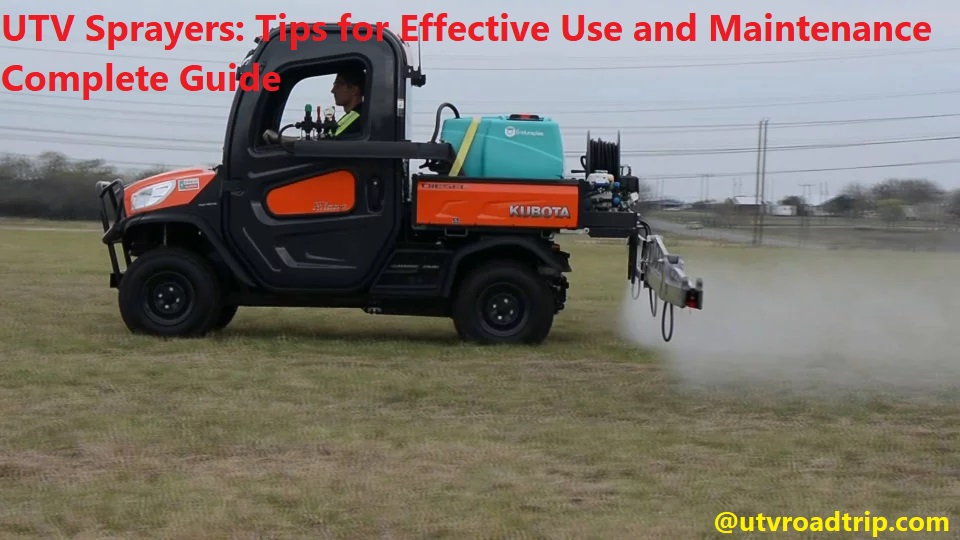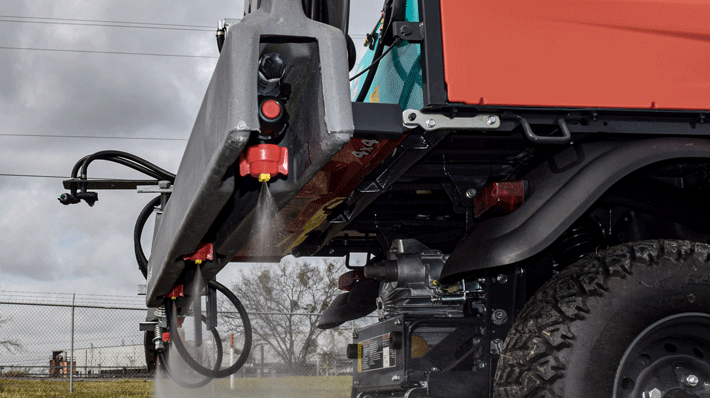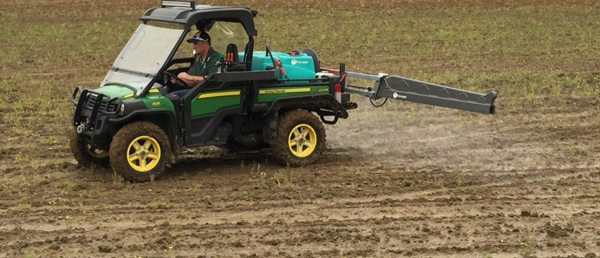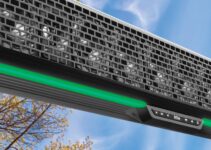Are you looking for a reliable, effective and efficient way of spraying UTVs? Do you want to extend the life of your UTV Sprayer?
In this guide, we will be discussing the various tips on how to get the most out of your UTV Spray System. You don’t want to miss out on all these important tips!
UTV (utility vehicle) spraying systems are becoming increasingly popular for effective application of agrichemicals, such as herbicides, insecticides and fungicides. UTV sprayers make it easier to cover large areas in a cost-effective way. Proper use and maintenance of a UTV sprayer can help eliminate unnecessary product waste and maximize the efficiency of the system. This guide provides an overview of tips for effective use and maintenance of UTV sprayers.
When using a UTV sprayer, be sure to read the manufacturer’s instructions carefully before operating. The specifics may change depending on your particular setup. In general, you should adjust the output pressure on the pump regulator until it is just slightly above the desired rate at which you need to apply your product. When you have reached the desired pressure setting, double check to make sure there are no leaks or problems with any components along the hose path. Also ensure there are no obstructions in or near paths where UTVs will be spraying that might impede an even coverage or cause overspray concerns via drift or runoff into other areas. Before beginning each application, test a small area manually with a flow meter or paddle to ensure accuracy and avoid under- or over-application.
Types of UTV Sprayers
There are various types of UTV Sprayers available in the market, and it’s important to select one that is right for your needs and budget. The different types of UTV Sprayers include boom sprayers, boomless sprayers, spot sprayers, high-clearance sprayers, herbicide sprayers, and more.
Boom Sprayers feature a basic track frame with a tank and a system of booms for faster and easier spraying. Boomless Sprayers have nozzles installed on the sides of the frame that let you cover large areas quickly. Spot Sprayers are designed specifically for spot application; they differ from boom sprayers because they are smaller and lighter in weight. High-Clearance Sprayers offer an excellent alternative to boom-type models; they feature taller frames that allow them to pass over tall crops like alfalfa or corn without needing to be modified.
Herbicide Spray Systems are designed specifically for spraying herbicides on sensitive crops such as soybeans and cotton; they offer adjustable nozzle functions, pressure regulation capabilities and corrosion protection than standard liquid delivery systems. Moldboard Plow Blades are also available in some models; these blades feature adjustable heights so you can plow fields more effectively while spraying liquid pesticides or fertilizers at the same time. Some UTVs also come with optional trailers, which can be used to tow additional tanks or other attachments when needed.

Explanation of the different types of UTV sprayers
UTV sprayers provide an efficient method of spraying large, hard to reach areas with precisely the right amount of liquid. These versatile machines are suitable for a variety of different tasks such as agricultural, turf and garden maintenance as well as public works applications. In order to maximize their effectiveness and longevity, it’s important to understand the different types available and the best practices for using and maintaining them.
There are three types of UTV sprayers: manual UTV sprayers, boom sprayers and boomless nozzles. Manual UTV sprayers typically feature two or four nozzles that operate independently from each other for targeted treatments. Boom sprayers feature two or three adjustable booms with matched nozzles that help ensure an even application across the entire area being treated. Lastly, boomless nozzles direct a large amounts water/liquid in a broad cone-shaped pattern over a wide span with very little droplet size variance; these are used more often when an area does not require precision application or coverage.
Whether you’re using an industry-specific UTV for your business or one for personal use, proper care is essential to get the most out of your equipment. Regular maintenance should include regular oil changes (at least once every year), tire pressure checks, pre-season hosing down to remove any debris buildup, filter cleaning (at least once a month) and regular fluid level checks. It’s also important to inspect all parts and hoses at each use and replace any worn out or broken components right away — this will ensure maximum efficiency during operation when you need it most!
Comparison of their features and benefits
UTV Sprayers come with a variety of features and benefits, which can make a big difference in the effectiveness and efficiency of your operations. To help you decide which UTV sprayer is right for you, here’s an overview of the most important characteristics to consider.
Power: UTV sprayers can range from low- to high-power applications, depending on the size of your project and terrain you’ll be working on. Lightweight models offer less power, but are typically more maneuverable in tight spaces or over rough terrain, while tough models with large tanks and powerful motors can tackle bigger jobs.
Range: For larger acreage or hard-to reach areas, look for models with longer ranges so you don’t have to frequently refill tanks. Some UTV sprayers also allow for remote control operation from up to 2 miles away.
Nozzle Types: Different nozzle types will enable different levels of precision when spraying around delicate plants, trees or shrubs – some even have 360 degree coverage. Consider pressure options too; higher pressured nozzles are better suited for larger areas,while lower pressures provide better coverage closer to plants. Finally check flow rates; generally lower rates provide a finer mist while higher rates cover more ground quickly.
Tank Capacity: The right tank capacity depends on what type and how much area needs spraying – small vineyards may require smaller tanks while larger farms may require large tanks capable of holding hundreds of gallons. Take into account how often and how far you will need to transport the tank – heavier tanks may be harder work but support long range applications without frequent refills.
Husky Pump Design: Look for UTV sprayers with full featured Huskydiaphragm pumps that provide excellent mixing versatility as well as numerous pressure settings optimized for uniform spraying action from dribble fine sprays up to heavy volume treatments over large acreage sizes.
Tips for Effective Use of UTV Sprayers
UTV sprayers are a convenient, versatile and practical way to distribute pesticides, herbicides, fertilizers and other liquids over agricultural crops or turf. Used in the right way, they can have dramatic effects on crops and turf, but like all tools, there are certain guidelines that need to be followed in order to maximize their potential and ensure safe use. Here are some tips for effective use of UTV sprayers:
- Make sure you understand the labeling instructions on all chemicals prior to use. Different chemicals will require different application rates and rates of dilution.
- When using herbicides, it is important to apply them when the plants are actively growing. If applied during dormancy or when optimal conditions for maximum absorption don’t exist such as excessively dry or wet soil conditions, liquid herbicide treatments may not be as effective in controlling weeds as desired or intended.
- Always check UTV sprayer tanks for proper chemical concentration before applying any materials. Pump nozzles must be set at the proper MPH rate which coincides with walking speed for optimal chemical uniformity across a given field/turf area being treated (ie 3-5MPH). This can usually be done by adjusting both pump speed and nozzle pressure settings located at the front of UTV Sprayer tanks while they are in operation.
- When treating an area with liquids on a UTV Sprayer such as herbicides/pesticides where drift potential is a concern due to wind direction/temperature conditions—sprayer operators should consider these factors prior making applications (If winds pick up suddenly put equipment away). Be sure not to overdress areas with excessive material which could result in non-uniform coverage causing “Burn out” of sensitive plants/turf varieties! Also consider using additives such as surfactants/deposition agents that enables droplets of pesticides/liquid products to stick more easily on target surfaces for consistent & uniform coverage without run off!).
- It is always good practice to inspect nozzles regularly for signs of degradation or wear and change them out when necessary in order to maintain accurate application rates throughout an entire treatment day!
Proper calibration of the sprayer
Before using your UTV sprayer, it is essential to calibrate the machine correctly so that you can get the desired coverage and application rate. Calibration may vary based on the type of nozzle used, but the goal is always to spray a given area with an even amount of solution with minimal droplet wastage.
Proper calibration begins with understanding the pressure and gallons per minute (GPM) at which you will be spraying; these two measurements effect how much area can be covered in a typical pass. If possible, try to use a pressure gauge to measure both input and output, and adjust as needed for accurate results. High pressure is important for atomization but too much can result in over-application or dripping from nozzles.
Next, it’s time to determine the correct spacing between nozzle outputs. The distance between nozzles should not be too close individually nor too far apart as a whole; this ensures proper coverage of larger areas for maximum efficiency. Generally speaking, lower pressures require shorter output spacings while higher pressures need more spacing. Finally, you’ll want to make sure nozzles are tilted correctly – they should be facing straight toward the targeted area with little deviation if possible.
When finished properly calibrating your UTV sprayer equipment according to manufacturer specifications or job requirements, check again after each operation and make adjustments if necessary. Regular maintenance is key – clean all nozzles routinely along with other components such as screens and filters – to help maintain optimal performance levels in between uses.
Choosing the correct nozzle for the application
When selecting the nozzle for use on your UTV sprayer, it is important to consider the application. Depending on the job, you may require different nozzles such as adjustable fan or flat fan nozzles that provide greater coverage, or air induction (AI) nozzles which create extremely fine particle sizes and improved coverage in challenging areas. Each type of nozzle is unique and has different characteristics, so it’s important to select the right one for your application.
Nozzle selection should also consider the volume of liquid and rate of speed necessary to complete an application. Low-flow and low-speed applications may require larger droplets which are best suited for an adjustable fan or other high-flow nozzle; while narrow angle sprays with low gallons per minute may require a flat fan nozzle to achieve maximum coverage in less time. For greater control over your application area, a combination of adjustable and flat fans, as well as AI nozzles should be used together.
It is also important to consider how a nozzle performs at various pressures when selecting a sprayer pump. Many adjustable fans will operate well up to 200 pounds per square inch (psi) whereas some AI nozzles are designed for higher pressure results up to 300 psi. Make sure you know what your ideal pump pressure should be prior to purchasing a system. In addition, many different types of chemical additives can affect spray performance; either increasing or decreasing your optimal pressure settings depending on their unique properties. This makes proper nozzle selection even more crucial when using any type of chemical additive with your UTV sprayer system.

Tips for UTV Sprayer Maintenance
Proper maintenance of a UTV sprayer will keep it in proper working order and should help to extend its lifespan. While UTV sprayers are relatively low-maintenance vehicles, it is still important to check them periodically and address any issues that arise. Here is a list of tips for effective use and maintenance of your UTV sprayer:
- Inspect the hoses, nozzles, and pumps regularly for any signs of wear or damage. Be sure to clean them with soap and water frequently.
- Ensure that you correctly attach the hoses to the tanks before each use, as improper attachment can lead to leaking chemicals or contamination from backflow into the tank or contaminating adjacent tanks.
- Clean the inside of the tank after each use with a solution of warm water and detergent to remove residues and prevent contamination from forming on its walls when you store it away between uses.
- Check all tires regularly for any signs of wear or damage, overinflation or under inflating, improper alignment, or partial inflation due to punctures that may have gone unnoticed while driving on rough surfaces. Proper tire pressure also ensures even distribution while spreading products which prevents additional strain on drive components such as axles, wheel bearings and suspension components in addition to efficiency gains brought on by rolling resistance reduction.
- Perform a general visual inspection at least once every week including major parts such as: Drive system components such as belts – Clutches – U-Joints – Differential Gears & Bearings – Brakes & Air Cylinders – Front Axle & Steering System – Chassis Components – Electrical Components.
6 Make sure all fluid levels are checked regularly (Engine Oil/Coolant/Hydraulic Fluid)and filled accordingly before every job is started up again for prolonged life expectancy of the unit.
Regular cleaning and inspection of the sprayer
To ensure that the sprayer remains in good working condition, you should clean and inspect it on a regular basis. This is especially important if it is used in the field for a long time and the hoses have to carry potentially harmful chemicals.
When cleaning the sprayer, use a mild detergent and warm water to remove any dirt or debris, then rinse thoroughly with clean water. Afterwards, make sure to inspect all parts of the sprayer for cracks, leaks or other damage that may have occurred during use. In addition, check if there are any blockages in any of the lines or connections that could impede fluid flow.
Make sure to keep all products used with the sprayer labeled clearly so they can be quickly identified when needed. Ensuring regular maintenance and cleaning of your UTV sprayer will help prolong its life and performance.
Proper storage of the sprayer
Taking the proper steps to store your UTV sprayer will help ensure it is in top condition when you’re ready to use it. It’s important to store the unit away from direct sunlight, as the sun’s ultraviolet rays can weaken the plastic tanks and other components in a matter of months. Keeping your UTV sprayer out of direct sunlight and protected from the elements like wind, rain, snow, and hail will help extend its lifespan. Additionally, you should also take measures to ensure that corrosion does not occur by regularly maintaining and inspecting the unit for signs of rust or wear-and-tear.
It’s a good practice to store your UTV sprayer completely drained of any liquids it contains. Locking all doors on your unit provides extra protection from unwanted visitors like rodents or insects that could potentially cause damage or contaminate stored materials like fertilizer. It’s also important to note that chemical spills in enclosed areas where this equipment is housed are a potential safety hazard; therefore, these areas should be well ventilated at all times. To ensure complete safe operation, professionals recommend reading the manufacturer’s instructions carefully before making use of any UTV sprayers.
Conclusion
In conclusion, UTV sprayers are versatile pieces of agricultural equipment that allow farmers, ranchers and landowners to easily fertilize their crops or landscape. No matter what your application, maintenance and operation of your UTV sprayer is key to maximize their lifetime value. Implementing these tips and tricks into your routine will ensure that your sprayer runs properly for years to come.
Be sure to read the manufacturer’s directions on how to set up and use the machine as well as any safety warnings that may be applicable. Regular servicing can also extend the life of the machine and help prevent costly repairs down the line.
Finally, be sure to always adhere to local regulations when applying fertilizers and pesticides with UTV sprayers. Following these practices will allow you to get the most out of your investment in an efficient and safe manner.

FAQ’S
What are the important cares and maintenance of sprayers?
Important cares and maintenance of sprayers include proper cleaning, storage, lubrication, and regular inspection of parts.
How do you maintain a pump sprayer?
To maintain a pump sprayer, it should be cleaned after each use, all parts should be checked for wear and tear, and lubrication should be applied to the pump and other moving parts.
How to operate and maintain after use the knapsack sprayer?
To operate a knapsack sprayer, it should be filled with the desired liquid, the nozzle adjusted, and the pump lever used to build up pressure. After use, it should be emptied, cleaned, and stored in a dry place.
How do you maintain hand spray?
To maintain a hand spray, it should be regularly cleaned, all parts checked for damage, and lubrication applied to the plunger and other moving parts.
What are five functions of a sprayer?
The five functions of a sprayer are mixing, agitation, filtration, spraying, and calibration.
What is the most important part of the sprayer?
The nozzle is often considered the most important part of a sprayer, as it controls the flow and distribution of the liquid being sprayed.
What are the principles of sprayers?
The principles of sprayers include creating and maintaining uniform droplets, delivering the right amount of liquid, achieving the desired coverage area, and minimizing drift.
What are the safety precautions of sprayers?
Safety precautions of sprayers include wearing protective clothing, avoiding inhaling or ingesting the liquid, using only approved chemicals, and following manufacturer instructions.
What are the procedures for cleaning the sprayer?
Procedures for cleaning a sprayer include flushing it with water, disassembling all parts, soaking them in a cleaning solution, and scrubbing them to remove residue.
Why the sprayer should be cleaned after use?
A sprayer should be cleaned after use to prevent chemical buildup, corrosion, and contamination of future applications.
See Also :


